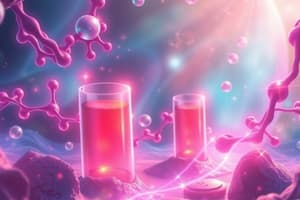Podcast
Questions and Answers
What is the primary mechanism by which Deep Brain Stimulation (DBS) treats movement and affective disorders?
What is the primary mechanism by which Deep Brain Stimulation (DBS) treats movement and affective disorders?
- Stimulation of the vagus nerve
- Alteration of the brain's electrical impulse patterns
- Unknown mechanism (correct)
- Stimulation of the nerve cells in the brain
Which of the following is NOT a typical application of Vagus Nerve Stimulation (VNS)?
Which of the following is NOT a typical application of Vagus Nerve Stimulation (VNS)?
- Parkinson's disease (correct)
- Treatment-resistant depression
- Chronic pain
- Obsessive-compulsive disorder (OCD)
What is the primary difference between Transcranial-Magnetic Stimulation (TMS) and Cranial Electrotherapy Stimulation (CES)?
What is the primary difference between Transcranial-Magnetic Stimulation (TMS) and Cranial Electrotherapy Stimulation (CES)?
- TMS uses electrodes on the ear lobes, CES uses a helmet
- TMS uses electrical currents, CES uses magnetic fields
- TMS treats depression, CES treats anxiety
- TMS is invasive, CES is non-invasive (correct)
What is the primary function of the device implanted in the body during Vagus Nerve Stimulation (VNS) therapy?
What is the primary function of the device implanted in the body during Vagus Nerve Stimulation (VNS) therapy?
Which treatment is used to treat essential tremor?
Which treatment is used to treat essential tremor?
Which of the following is a non-invasive procedure?
Which of the following is a non-invasive procedure?
Which treatment is used to treat major depression?
Which treatment is used to treat major depression?
What is the primary location of the electrodes in Cranial Electrotherapy Stimulation (CES) therapy?
What is the primary location of the electrodes in Cranial Electrotherapy Stimulation (CES) therapy?
What is the primary function of the vagus nerve in Vagus Nerve Stimulation (VNS) therapy?
What is the primary function of the vagus nerve in Vagus Nerve Stimulation (VNS) therapy?
When was Deep Brain Stimulation (DBS) first introduced?
When was Deep Brain Stimulation (DBS) first introduced?
Flashcards are hidden until you start studying
Study Notes
MAO Inhibitors
- Non-selective MAO inhibitors (irreversible): Phenelzine (Nardil®), Isocarboxazid (Marplan®), Tranylcypromine (Parnate®)
- Selective MAO-A inhibitors (reversible): Moclobemide (Aurorix®)
- Pharmacokinetics: Well absorbed from the GIT, extensive first-pass effects may decrease bioavailability
- Therapeutic uses: Treatment of depression unresponsive to other antidepressants, anxiety disorders, and Parkinson's disease
- Contraindications: Use with other antidepressants due to risk of serotonin syndrome
- Drug switching: Wait 2 weeks after discontinuing another antidepressant before initiating an MAOI, except for Fluoxetine (wait 5-6 weeks)
Atypical Antidepressants
- Tetracyclic and unicyclic antidepressants with unique mechanisms of action
- Bupropion (Wellbutrin®): Weak norepinephrine dopamine reuptake inhibitor (NDRI), indicated for major depressive disorder, seasonal affective disorder, smoking cessation, and ADHD
- Mirtazapine (Remeron®): Blocks presynaptic α2-receptors, enhancing norepinephrine and serotonin release, used for major depressive disorder
Serotonin/Norepinephrine Reuptake Inhibitors (SNRIs)
- Inhibit reuptake of serotonin and norepinephrine into the presynaptic neuron
- May be effective in depression accompanied by chronic painful symptoms
- May produce serotonin syndrome and withdrawal syndrome
- Venlafaxine (Effexor®) and Desvenlafaxine (Pristiq®): Potent inhibitors of serotonin reuptake and norepinephrine reuptake at higher doses
Other Treatments
- Thyroid hormones: Play a role in cognitive function, mood, and emotions
- Buspirone: Used as an augmenting agent
- Second-generation antipsychotics: Used as adjustments to antidepressant therapy
- Omega-3 fatty acids, folate, and vitamin B: May play a role in certain cases of depression
- Combination therapy: Overcomes adverse effects, uses lower doses, and adds therapeutics effects
- Electroconvulsive therapy (ECT): High rates of response and remission, used for refractory depression, depression in pregnancy, and psychotic depression
- Medical devices therapy:
- Deep brain stimulation (DBS): Used for treatment-resistant movement and affective disorders
- Vagus nerve stimulation (VNS): Used for treatment-resistant depression
- Transcranial-magnetic stimulation (TMS): Used for treatment-resistant depression
- Cranial electrotherapy stimulation (CES): Used for anxiety, depression, insomnia, and chronic pain
Studying That Suits You
Use AI to generate personalized quizzes and flashcards to suit your learning preferences.




